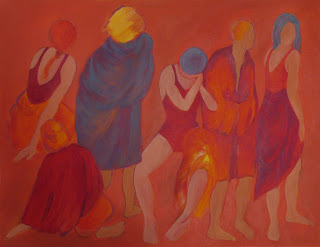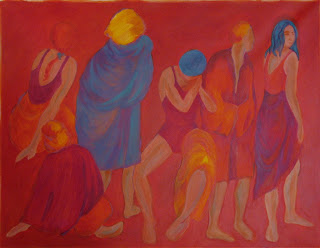Friday, June 30, 2017
Get out the sunscreen!
Wishfully waiting for summer about a month and a half ago, I began the seventh in my "Flash Mob" paintings by presenting my familiar lounging swimmers under wraps.
It was a good opportunity to play with fabric folds and also to splash around on my new-bought **pristine** artist's paper from Arches, the French mill that makes some of the best.
Maybe it all went a little too smoothly -- because working over an old painting provides a useful resistance, both texturally and tonally. Working against that can slow you down but also give necessary pauses in which to consider and reconsider.
And so somehow, I let a troublesome figure establish herself.
The female figure on the far right was so intriguing in my original sketchbook -- the position of her feet, the twist in her spine as she looked back over her shoulder.
But from the first transposition from original quick sketch to paper-doll study, her head just didn't work.
It was too big. It was too small. (You can view the inflationary/deflationary cycle here) Finally I said, "Let's wrap this up" -- and went with what I had.
Here's "It's a Wrap" (copyright 2017)
Sometimes, you've just gotta throw in the towel -- or wrap it around your shoulders -- pull yourself away to the sidelines, and mull over how you might make the cut next time.
Friday, June 16, 2017
Call up the troops
Just a few years ago in reading about the Impressionists, I learned about one of their predecessors, Ernest Meissonier. His paintings don't appeal to me (nor did they to our Impressionist heroes), but I was struck by how he planned his complex, populated scenes like his "Battle of Friedland" shown here. He actually commissioned the construction of hundreds of small-scale 3D horses and riders, organized them into a "composition," and painted from the model, as it were.
It certainly makes sense. Even as I experiment with compositions for my Flash Mob series, with at most nine figures involved, it can get tedious to make a dozen preliminary pencil sketches.
Last summer, when I first started doing multi-figure paintings, I found that the quickest way to try out different compositions was to make paper cut-outs that could be easily moved around.
As I drew and cut out these little figures, I was reminded of my mother's story of her paper-dolls. As a committed tomboy in the early 1950s (and ever afterwards), I'd been somewhat mystified by the debut of the briefly famous paper-doll Betsy McCall. The celebrated offspring of the then-classy McCall's women's magazine, she was a sturdy little paper-girl just my age.
Each month, she'd arrive with a whole new wardrobe -- tidy perfect dresses that were similar but very superior to the kind of dresses my friends and I wore to school. These, and the spotless shoes and socks -- and the fact that she was out in public in her underwear?!? -- I found appalling rather than appealing.
"Oh, I loved my paper-dolls!" my mother said. In her day, little girls didn't assemble pre-packaged Betsys, but gleaned the magazines for an appealing figure, cut it out, mounted it on cardboard -- and then made up stories for the figures to enact. Right. Typical kids' stuff like the scenarios I developed with my panda and teddy bears.
"And my favourite paper-doll," she said, "was named Elizabeth Barrett Browning -- because it was the most beautiful name I'd ever heard."
Remembering all this -- Betsy, my mom, and Elizabeth B -- I spent one amusing studio session last summer making tabbed outfits for a couple of my figures.
The jester particularly became the presiding genie as I worked on my first figure painting, "Catching the Rays."
The paper-doll approach has turned out to be useful with the two most recent paintings I've been working on. And if I'd saved my original group and put them with my current gang, I'd have more than enough of a crowd to stare down the galloping horses and invite everyone to a big beach party.
You've probably found this to be a very silly post. So let's give the last word to Elizabeth Barrett Browning, who wrote: "Silence is the best response to fools."
Subscribe to:
Posts (Atom)















